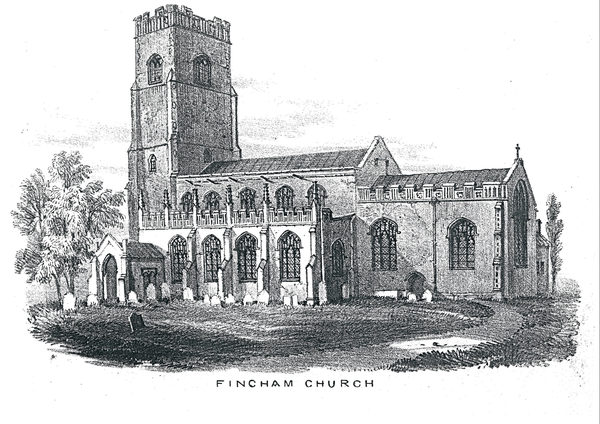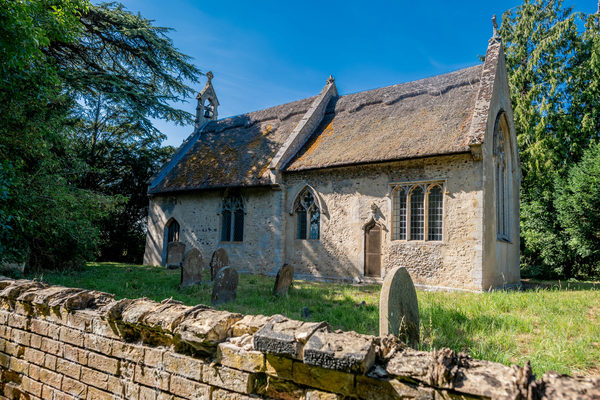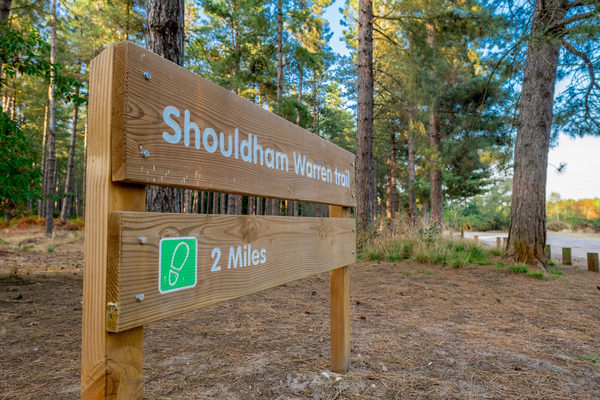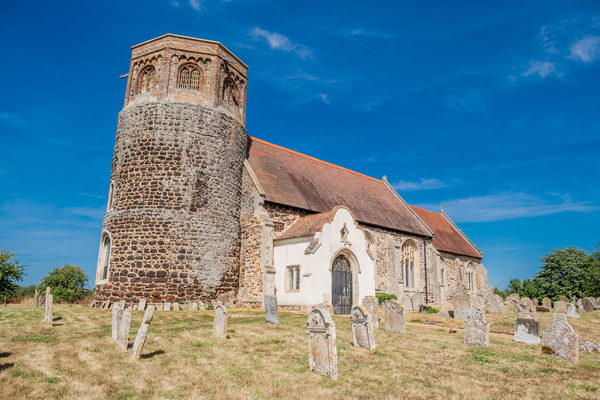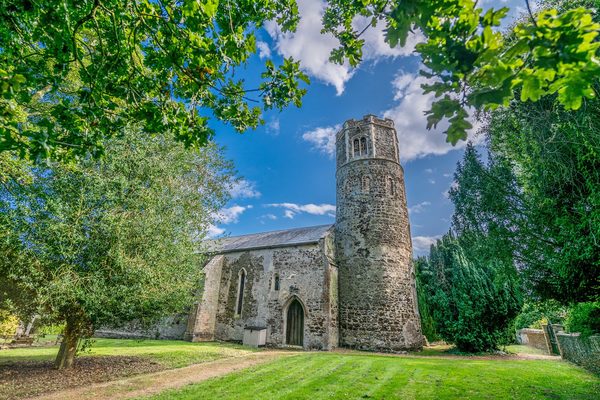St Martin's was one of two churches in this village, until St Michael's, two hundred metres to the west, was abandoned in 1745 after its tower fell. The two parishes were formally consolidated in 1787, when permission was given to pull down the ruins of St Michael's and use the proceeds to repair St Martin's. The imposing tower has flush work panels decorating the diagonal buttress faces and the stepped parapet. These panels include the crowned M for the Blessed Virgin Mary and IHC (the first three letters of the Greek word for Jesus). Simon Fyncham left £7. 7s 8d to the fabric of the belfry in 1458 and the Fincham arms are also to be seen. There is a fine west doorway, with proud lions supporting the square hood mould, and above it a large four-light west window. Around the base of the tower is a stone course with trefoil-headed blank arches. There are six bells, which were recast by John Taylor & Co, Loughborough, in 1976.
This church was given an extensive rebuilding in the Perpendicular style around 1450, and the south aisle in particular was made to impress. The south porch has the misleading date 1852 on its parapet, which was when repairs were made, referred to as beautification of the church on one of the wall plaques. There is a chequered base course to the south aisle and above the large straight-mullioned windows are battlements adorned with flush work panels and crocketted pinnacles topping the buttresses. There are also large stone gargoyles of amusing grotesques, allowing the rainwater to drain from the nearly flat roof behind. Higher still is a colourful clerestory built of flint, brick and carrstone, with five three-light windows on the south side and an additional smaller one in the east gable of the nave. The chancel is less decorative as it is rendered, marked to look as if it were made of stone, although the south parapet is battlemented flint work. The five-light east window has been restored, but is still very impressive. There is a priest's door on the south side and on the north is a vestry built by Sir Nicholas Fincham in c.1503. He also provided an extra room above the vestry for the use of an assistant priest. The north aisle has a plain parapet, clerestory windows of two-lights, and a north door, but no porch.
The chief delight of this church is the magnificent Norman font that was originally in St Michael's church. It is one of thirteen square Norman fonts still surviving in north-west Norfolk and of those, one of the three that have figures carved on the sides of the bowl. [The others are at Burnham Deepdale and Sculthorpe]. They stand under carved rounded arches resting on Norman pillars. Above and below are bands with an ‘X’ pattern. The east side of the bowl shows the three Magi bearing gifts. To the south are Mary, Joseph, the Baby in the manger, the heads of the donkey and an ox, and a star. The west shows the Baptism of Jesus flanked by St John the Baptist and a Bishop. The north side has Adam and Eve either side of the repaired Tree of Life containing the serpent.
The substantial eastern buttresses of the tower are to be seen within the church and there is a very tall tower arch. The west window has glass made by Wilmshurst & Oliphant showing the four Evangelists, remembering George Aylmer, who died in 1852. The nave has four fine slender pillars to each arcade, with the roof above being supported by alternate large and small hammer beams, the smaller ones being above the clerestory windows where is no space for wall posts. The hammer ends are adorned with figures, mostly angels, but the third from the east end on the south appears to be a green man, while opposite it is a fierce devil's head with pointed ears. The green man, a head enclosed with foliage and often with leaves sprouting from the mouth, is thought to be a fertility symbol dating back to pagan times. The angels are similar to those seen at Mildenhall and Outwell. There are six boards with Bible texts adorning the walls of the nave dated 1717. In addition, above the south doorway is the Creed and above the former north doorway the panel starts "And it came to pass that as he was praying ", when Jesus gave his disciples the Lord's Prayer (St Luke's Gospel, chapter 1). The Ten Commandments are displayed on the north and south tower walls. The pulpit is Victorian and nearby on the wall is a lengthy, but fragmentary, brass inscription, remembering Thomas Townsend, who died in 1572. The pews are also Victorian work, but incorporate old poppy heads, including several eagles. From the east end of the north aisle is a hagioscope, or "squint", cut through the thickness of the wall, so that the priest officiating at the side altar in the aisle could see the priest at the high altar in the chancel and synchronize both offerings of the Mass. This squint is particularly long, extending about six feet through the masonry. The chancel screen is a tall example of 15C work, with finely carved tracery, including crocketted pinnacles, and double cusping around the centre arch. In the apex of this wide entrance arch into the chancel are the arms of the Fincham family, indicating that they were the donors. The panels retain some of their colouring with a floral decoration and around the frames of the panels are gold scroll patterns on a black background. The chancel was restored by Miss Hebgin in 1870 and there are memorials to several Hebgins, including the south east window, which shows the supper at Emmaus, when Jesus revealed himself to Simon and Cleopas after His Resurrection (St Luke chapter 24). The other coloured glass window in the chancel shows the Presentation in the Temple and remembers the Rev'd William Blyth, who died in 1886.
The remaining window in the chancel has medieval glass with images of angels playing different instruments.
